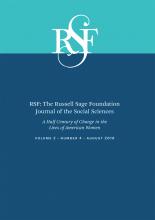Research Article
Open Access
Trends in Relative Earnings and Marital Dissolution: Are Wives Who Outearn Their Husbands Still More Likely to Divorce?
Christine R. Schwartz, Pilar Gonalons-Pons
RSF: The Russell Sage Foundation Journal of the Social Sciences August 2016, 2 (4) 218-236; DOI: https://doi.org/10.7758/RSF.2016.2.4.08
Christine R. Schwartz
aProfessor of sociology at the University of Wisconsin-Madison, Department of Sociology, University of Wisconsin-Madison
Pilar Gonalons-Pons
bPostdoctoral fellow at Goethe University Frankfurt am Main, School of Social Sciences (FB03), Goethe University Frankfurt am Main

REFERENCES
- ↵
- Autor, David H
- ↵Becker, Gary S. 1981. A Treatise on the Family. Cambridge, Mass.: Harvard University Press.
- ↵
- ↵
- Brines, Julie, and
- Kara Joyner
- ↵
- Buss, David M.,
- Todd K. Shackelford, ,
- Lee A. Kirkpatrick, , and
- Randy J. Larsen
- ↵
- Cha, Youngjoo
- ↵
- Charles, Kerwin Kofi, and
- Melvin Stephens
- ↵
- ↵Cotter, David A., Joan M. Hermsen, and Reeve Vanneman. 2014. “Back on Track? The Stall and Rebound in Support for Women's New Roles in Work and Politics, 1977–2012.” New York: Council on Contemporary Families.
- ↵Dechter, Aimée R. 1992. “The Effect of Women's Economic Independence on Union Dissolution.” CDE working paper no. 92–28. Madison: University of Wisconsin–Madison.
- ↵DeNavas-Walt, Carmen, and Bernadette D. Proctor. 2014. “Income and Poverty in the United States: 2013.” Current Population Reports, series P60, no. 249. Washington: U.S. Government Printing Office for U.S. Census Bureau.
- ↵DeNavas-Walt, Carmen, Bernadette D. Proctor, and Jessica C. Smith. 2013. “Income, Poverty, and Health Insurance Coverage in the United States: 2012.” Current Population Reports, series P60, no. 245. Washington: U.S. Government Printing Office for U.S. Census Bureau.
- ↵Deutsch, Francine. 1999. Halving It All: How Equally Shared Parenting Works. Cambridge, Mass.: Harvard University Press.
- ↵
- ↵
- England, Paula
- ↵
- Fisman, Raymond,
- Sheena S. Iyengar, ,
- Emir Kamenica, , and
- Itamar Simonson
- ↵Fry, Richard, and D'Vera Cohn. 2010. “Women, Men, and the New Economics of Marriage.” Washington, D.C.: Pew Research Center. Accessed April 6, 2016. http://www.pewsocialtrends.org/files/2010/11/new-economics-of-marriage.pdf.
- ↵Gerson, Kathleen. 2010. The Unfinished Revolution: How a New Generation Is Reshaping Family, Work, and Gender in America. Oxford: Oxford University Press.
- ↵
- ↵Goldscheider, Frances K., and Linda J. Waite. 1991. New Families, No Families? The Transformation of the American Home. Berkeley: University of California Press.
- ↵Gouskova, Elena, Steven G. Herringa, Katherine McGonagle, and Robert F. Schoeni. 2008. “Panel Study of Income Dynamics, Revised Longitudinal Weights, 1993–2005.” Ann Arbor: University of Michigan.
- ↵
- Gupta, Sanjiv
- ↵Hays, Sharon. 1998. The Cultural Contradictions of Motherhood. New Haven, Conn.: Yale University Press.
- ↵
- Heckert, D. Alex,
- Thomas C. Nowak, , and
- Kay A. Snyder
- ↵
- Hitsch, Günter J.,
- Ali Hortaçsu, , and
- Dan Ariely
- ↵
- Jacobs, Jerry A., and
- Kathleen Gerson
- ↵
- Johnson, William R. and
- Jonathan Skinner
- ↵
- Kalmijn, Matthijs,
- Anneke Loeve, , and
- Dorien Manting
- ↵
- Kaukinen, Catherine
- Killewald, Alexandra. Forthcoming. “Money, Work, and Marital Stability: Assessing Change in the Determinants of Divorce.” American Sociological Review.
- ↵Lareau, Annette. 2003. Unequal Childhoods: Class, Race, and Family Life. Berkeley: University of California Press.
- ↵
- Lillard, Lee A., and
- Constantijn W. A. Panis
- ↵Ludden, Jennifer. 2010. “Modern Marriages: The Rise of the Sugar Mama.” National Public Radio: Morning Edition, January 19. Accessed April 6, 2016. http://www.npr.org/templates/story/story.php?storyId = 122612096.
- ↵
- Nock, Steven L
- ↵
- Oppenheimer, Valerie Kincade
- ↵
- Panel Study of Income Dynamics, public use dataset. 2012. Produced and distributed by the Survey Research Center, Institute for Social Research, University of Michigan. Ann Arbor.
- ↵
- Poortman, Anne-Rigt
- ↵
- ↵Ridgeway, Cecilia L. 2011. Framed by Gender: How Gender Inequality Persists in the Modern World. New York: Oxford University Press.
- ↵Roberts, Sam. 2010. “More Men Marrying Wealthier Women.” New York Times, January 19.
- ↵
- Rogers, Stacey J
- ↵Ruggles, Steven. 2014. “Marriage, Family Systems, and Economic Opportunity in the United States Since 1850.” Minnesota Population Center working paper no. 2014–11. Minneapolis: University of Minnesota. Accessed April 6, 2016. http://www.hist.umn.edu/∼ruggles/Articles/Ruggles_Marriage_2014.pdf.
- ↵Ruggles, Steven, J. Trent Alexander, Katie Genadek, Ronald Goeken, Matthew B. Schroeder, and Matthew Sobek. 2010. Integrated Public Use Microdata Series: Version 5.0. [Machine-readable database]. Minneapolis: University of Minnesota.
- ↵
- Sayer, Liana C., and
- Suzanne M. Bianchi
- ↵
- ↵
- Sen, Bisakha
- ↵
- Shows, Carla, and
- Naomi Gerstel
- ↵
- South, Scott J
- ↵Stanfors, Maria A., and Frances K. Goldscheider. 2015. “The Forest and the Trees: Industrialization, Demographic Change, and the Ongoing Gender Revolution in the United States and Sweden, 1870–2010.” Stockholm Research Reports in Demography 2015: 18. Stockholm: Stockholm University.
- ↵
- Sweeney, Megan M
- ↵
- Teachman, Jay D
- ↵
- Tichenor, Veronica Jaris
- ↵
- Tichenor, Veronica Jaris
- ↵Tierney, John. 2006. “Male Pride and Female Prejudice.” New York Times, January 3. Accessed April 26, 2016. http://query.nytimes.com/gst/fullpage.html?res = 9902EFDF1130F930A35752C0A9609C8B63.
- ↵
- ↵
- Weiss, Yoram, and
- Robert J. Willis
- ↵
- West, Candace, and
- Don H Zimmerman
- ↵Willinger, Beth. 1993. “Resistance and Change: College Men's Attitudes Toward Family and Work in the 1980s.” In Men, Work, and Family, edited by Jane C. Hood. Newbury Park, Calif.: Sage Publications.
- ↵
- Winkler, Anne E.,
- Timothy D. McBride, , and
- Courtney Andrews
- ↵
- Xie, Yu,
- James M Raymo, ,
- Kimberly Goyette, , and
- Arland Thornton
In this issue
Trends in Relative Earnings and Marital Dissolution: Are Wives Who Outearn Their Husbands Still More Likely to Divorce?
Christine R. Schwartz, Pilar Gonalons-Pons
RSF: The Russell Sage Foundation Journal of the Social Sciences Aug 2016, 2 (4) 218-236; DOI: 10.7758/RSF.2016.2.4.08
Jump to section
Related Articles
- No related articles found.
Cited By...
- No citing articles found.





